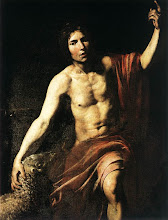Just saw the movie of the name above. Very keen to see it following David Stratton calling it one of the greatest films ever made in Australia and he and Margaret Pomeranz both giving it 5 stars! It may be that I need to sleep on it a bit to get the whole idea, but sadly I'm not sure I can agree with them. (Possible plot spoilers to follow, as they say…)
Strengths: any film about modern Aboriginal life has to be useful. It is ridiculous that Australians like me who've lived here most of our lives still know virtually nothing about the realities of modern day life for black Australians in the Outback. I couldn't tell you the first thing about life in Arnhem Land or the NT. This movie shows us that black rural teens need love too and often need help. From a Christian point of view, there is clearly an awareness of Christ and/or the Church in the lives of the indigenous people as when we see crosses on the wall etc. However, there is a telling moment when Delilah visits a Church in what I guess is Alice Springs. She seems to admire the artwork more than anything but is in desperate need of personal help. A priest comes and stands nearby with his hands clasped behind his back. She doesn't ask for help and just leaves. He says nothing but just watches her go. It seems a pretty unsubtle symbolic statement about the Church standing by idly while black people suffer. For people like me who feel the Church exists in order to actively engage with, and improve the lives of, the disadvantaged and needy, it irks!
The acting is largely impressive and believable, though I don't think I ever felt as emotionally engaged as I have in some other films. It keeps your attention at every moment, though. Occasional moments of strong violence out of nowhere are genuinely shocking. The amount of petrol-sniffing is concerning – you want to reach up on screen and grab that tin out of his hands. The monotony and hopelessness of many black lives is obvious.
Weaknesses: I guess it's arguable how subtle the performances and themes really are. The title suggests hair-cutting will occur, and it does, but does it lead to a loss of power and disaster? Apparently not, though one can't see how the relationship can be sustained. It reminded me a bit of Bad Boy Bubby in some ways – disturbing images set in present day Australia, making us wonder how well we can ever know what goes on in this big place. (Memo – must see Wolf Creek sometime too – I see John Jarratt out in the street quite often so can probably enjoy his performance a little more, knowing he's not really a psycho…) The lack of dialogue is also apparently deliberate but without a great deal of plot motivation. It reminds us that indigenous people don't necessarily need to say much to communicate, but all the same, it can be frustrating to watch!
It's certainly very non-Hollywood and I guess that's a refreshing change, but I just can't help thinking of plot turns that could have been created, especially involving the art work involved etc. Maybe my sense of pace is just too Western and white.
I was watching it, asking myself constantly whether I could show it in Yr 11 or Yr 12 English, or even RAVE, but I'm just not sure. What point does it ultimately make about indigenous Australians? Is it ultimately a positive portrait? Does it make us question what's happening out there or just think it's all a hopeless case for the 'too hard' basket?
I'll see how I feel about it tomorrow.

No comments:
Post a Comment